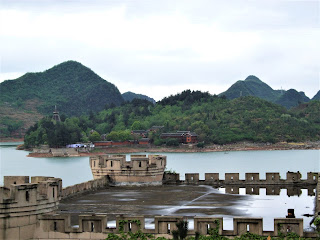GUIZHOU APR 2010
13 Apr 2021
Anshun to Guiyang
In the morning, we headed toward Guiyang. The afternoon
itineraries were Tianlong Tunpu Village, followed by a visit to an Miao Ethnic Village and then to view the beautiful Dongfeng Lake.
Tianlong Tunpu Village (See notes below)
Tunpu Museum
Tunpu
Village and descendents
The agriculture land
Tunpu preserved culture and drama from the Ming dynasty
Dixi Opera which is a kind of drama kept from ancient Ming
period with performers wearing masks, colorful long skirts and battle banners
to encourage armies and frighten enemies.
Miao Ethnic Village
We were warmly welcome by the villagers with
rice wine offered as we entered. A cultural dances were performed and we participated in their traditional dances followed by some fun games.
Hongfeng Lake. On our return to Guiyang City,
we stopped by Hongfeng Lake and took a lake cruise, This is the largest artificial lake on the Guizhou Plateau built
in 1958.We just tour a single spot of this huge lake.
Shenxiang
mountain
The tunpu (village fortress) in Anshun, Guizhou, was built
during the Ming Dynasty (600 years ago) for military use. During the early
period of the Ming Dynasty, Emperor Zhu
Yuanzhang sent Han national troops from the middle and lower reaches of the
Changjiang (Yangtze) River to Anshun. The garrison forces were ancestors of the
inhabitants of the "Tunpu," who built stone-structured villages and
turned the neighborhood into farmland for growing crops. In those days,
soldiers spent most of their days working as farmers. Only in times of war were
they called to unify and repel an enemy. Today, the area retains its original
style and pace of life.
Tianlong Tunpu is one such village fortress. It is
located in Pingba County of Anshun, 72 kilometers from the capital city Guiyang. Tianlong Tunpu occupies a strategic position, guarding what was
once an important passage to Yunnan Province. Therefore, Emperor Zhu Yuanzhang of the Ming Dynasty placed much importance on this village and sent large
numbers of troops to garrison it.
The name
“"Tianlong” comes from a combination of the names of two mountain ranges,
Tiantai Mountain and Longyang Mountain, that surround the village. Despite the
changing dynasties and the passage of hundreds of years, residents of Tianlong
Tunpu still live in forts and maintain a simple, peculiar army style of living.
They retain their traditional Ming lifestyle, clothing and hairstyle, and are a
distinct branch of the Han Ethnic people called the Tunpu.

































































































No comments:
Post a Comment